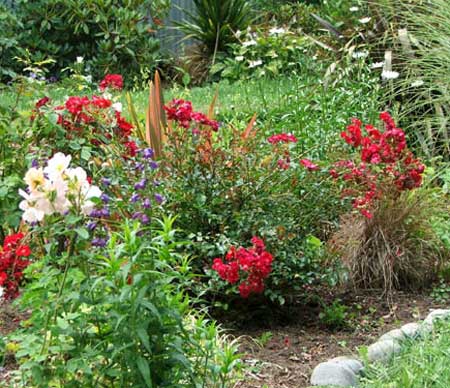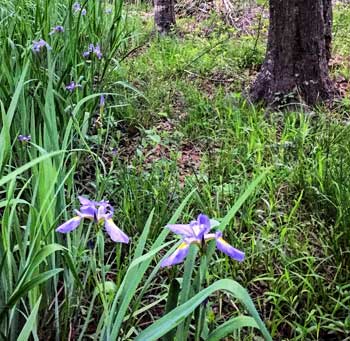Five Simple Ideas for Getting Started with Texas Native Plants

Preview of the Yard Sign to be sold for $10 each at the 2020 Wildscapes Workshop online sale. Click the “Wildscapes” tab for more information.
Here are five simple ideas to get you started growing local native plants in the Greater Houston Area. Additional online resources are linked at the bottom of this page. Remember… You are not alone. NPSOT Houston Chapter and its members are here to help you get started growing native Texas plants to support wildlife and better the sustain the environment.
Idea #1 – Got a sunny patch of ground? Plant some native plant seeds.

Photo: Russ Kane, NPSOT Member
One of the simplest ways to start growing native Texas plants is to start with native Texas wildflower seeds. Order a Texas wildflower seed mix online (Examples: Wildseed Farms Texas Oklahoma Mix, and Native American Seed’s Bee, Butterfly and Hummingbird Mixes) – buy enough for the size of the area you are planting. Follow the directions on the package or on the website. Most say to clear the ground without excessive tilling (a rake will do nicely). Then, check the seed package for any seed preparation instructions.
Plant the seeds within ¼-inch of the prepared surface and simply walk on the ground to pack in the seeds with the surrounding dirt. Keep the area moist until the seeds start to sprout and follow with periodic watering if no rain.
Idea #2 – You don’t have to yank out your beloved roses – just add a few native flowering plants.

Photo: mooseyscountrygarden.com
There are many native Texas plants that are great companions to roses and that have similar needs for water and sun. Many taller plants with flower spikes (Blazing star) or long stemmed flowers (Rough Leaf Coneflowers) provide a contrast to roses that have a softer form. Many native plants attract beneficial insects and birds to your yard that act as a natural way to control pests. A native ground cover like Frog Fruit will manageably help retain soil moisture and attract bees.
Idea #3 – Add a pollinator garden of native flowering plants.

Pollinator Attracting Prairie Garden
Take a small space in your lawn (10’x10’ or 20’x5’) where a splash of color would be good. It is high time to plant your pollinator garden that will be both pleasant to the eye and bring a plethora of butterflies, bees and birds while reducing the amount of water hungry grass in your yard.
Simply outline the area with stones or bricks (or not). Then, deposit 10-15 bags of sandy loamy topsoil. Make a trip to your local native garden store and pick up 10-15 plants that include: native milkweeds, Blue Mistflower, Butterfly Gaura, Blue Sage, Scarlet Sage, Texas Lantana, Indian Blanket, Brown-eyed Susan, Rattlesnake Master. You can also put in a trellis and plant a native Crossvine, Passionflower and/or Coral Honeysuckle that will attract hummingbirds and still more butterflies.
Idea #4 – Plant small native trees or shrubs under existing shade trees.
Photo: James Holmes, NPSOT Member
Have a yard with a large canopy tree or two that shades your yard to the point where grass doesn’t grow and the usual exotic flowers don’t bloom? The solution is to plant several small native trees and bushes that will thrive in the shade. They will provide landscape layering and provide food and shelter for your local birds. Examples of small native understory trees are Fringetree, Eastern Redbud and Mexican Plum. For shrubs and groundcovers, include Strawberry Bush, Coralberry, Turk’s Cap and Pigeonberry.
#5 – Have a patch that is periodically wet? Plant a native water garden.

Photo: Russ Kane, NPSOT Member
The Houston area gets a lot of rain. Rain events, when combined with our flat, dense clayey soils, create situations where rainwater will stand forming small temporary pools. You can either bring in the dirt to fill them in or install expensive French drains. Or, you can make a “rain garden”. Over tens of thousands of years, many of our local native plants have adapted to our region’s periodic inundations.
A well-designed rain garden that utilizes our native plants can be both functional (will dissipate standing water), beautiful and sustain our local pollinators, birds, and wildlife. If you have enough room, include a water-loving Bald Cypress or for closer quarters add smaller trees and shrubs like Sweet Bay Magnolia, Fringe Tree, Parsley Hawthorn, Virginia Sweetspire or Buttonbush. Jazz things up with flowering plants such as Spider Lily, Iris, Scarlet Sage, and Gulf Coast Penstemon.
Resources
- Full Native Plant Information Guide (PDF for printing)
Attracting Wildlife
- Plants that attract butterflies
- Plants that attract hummingbirds
- Trees that attract birds
- All about Monarchs & Milkweeds
- Houston Audubon’s Bird Friendly website
Planning
- Top 100 native plants for Harris and surrounding counties
- Common native trees
- Local sources of native plants
Note: NPSOT_HOU does not recommend specific vendors; availability of plant stock from vendors varies seasonally). - Information on Nine Natives Program from HNPAT (Houston Chapter – Native Prairies Association of Texas) and KPC (Katy Prairie Conservancy)
This program helps those new to native plants. The program recommends nine natives (and a few alternates) that are commercially available, easy to grow, and in combination will bloom throughout the seasons. Pick nine native plants and use template for laying out your new native plant garden.
Events and Programs
Learn more and link-up with others… You are not alone.
- Look for native plant sales like at NPSOT Houston Chapter’s Wildscapes Workshop held annually in September and those held at local arboretums.
- Learn more about landscaping with local native plants in the NPSOT Houston Chapter Native Landscaping Certification Program. Each level of certification provides a detailed plant list and growing information for 45 local native plants.
- Meet and discuss growing native plants with others by attending an NPSOT Houston Chapter monthly meeting and become a member of the NPSOT Houston Chapter.


